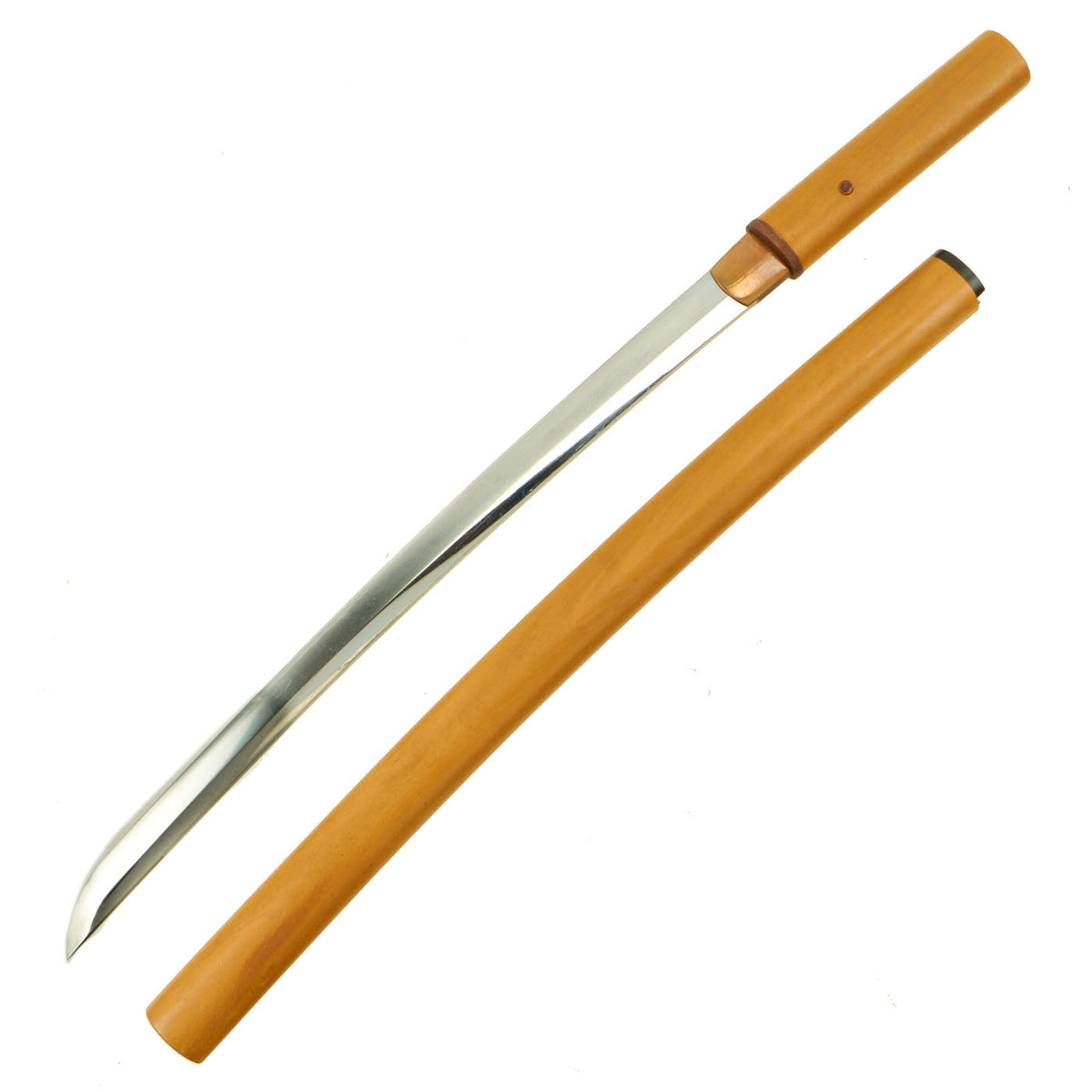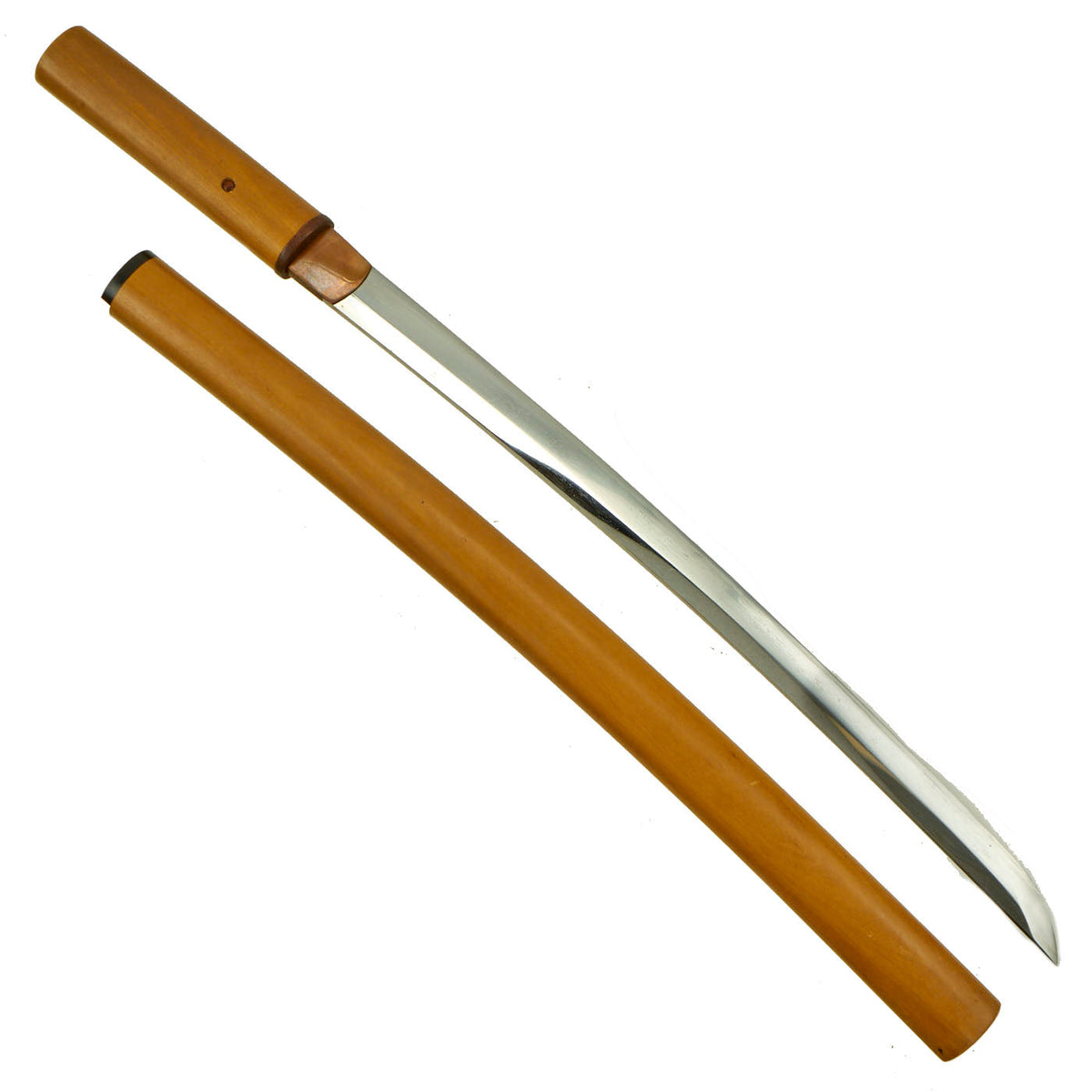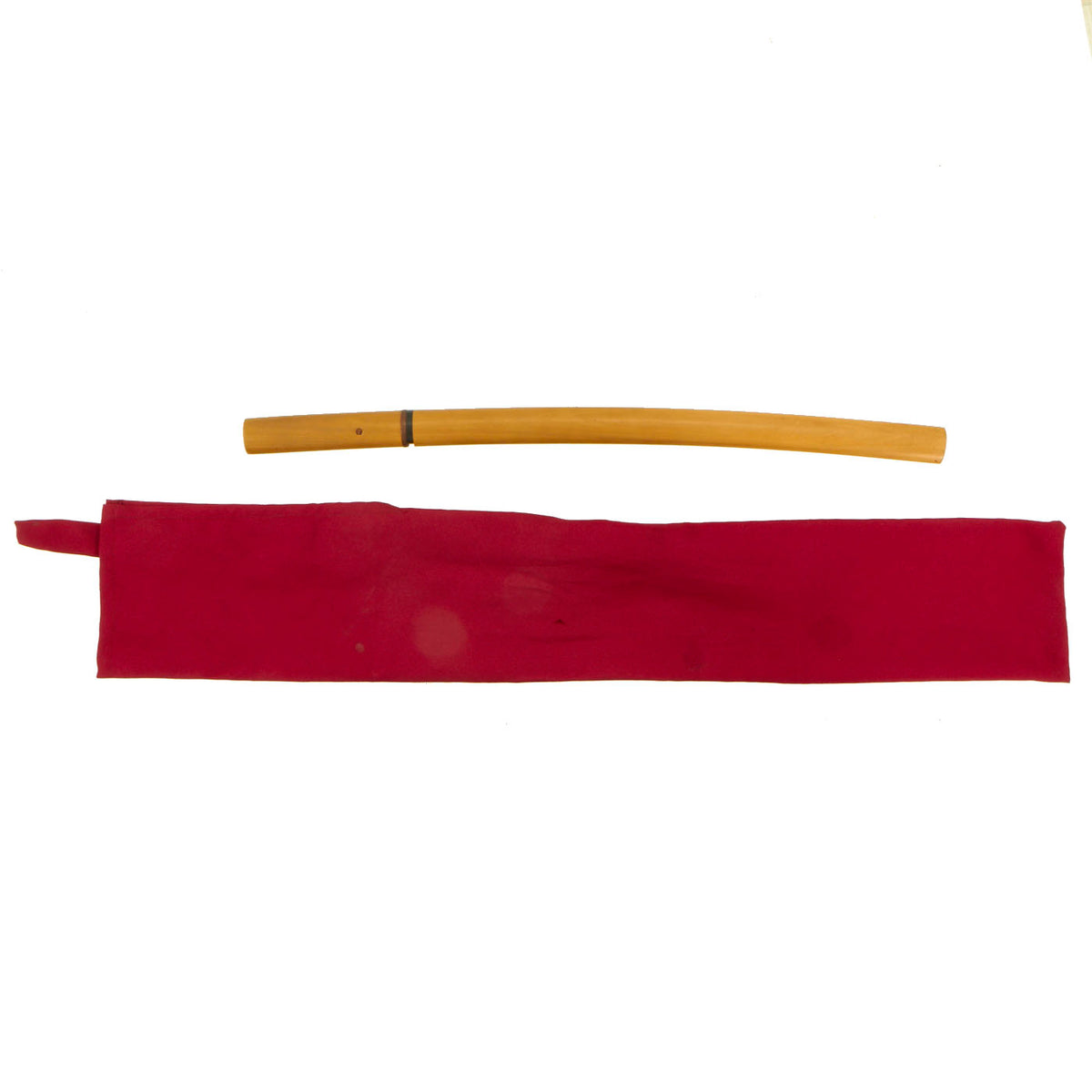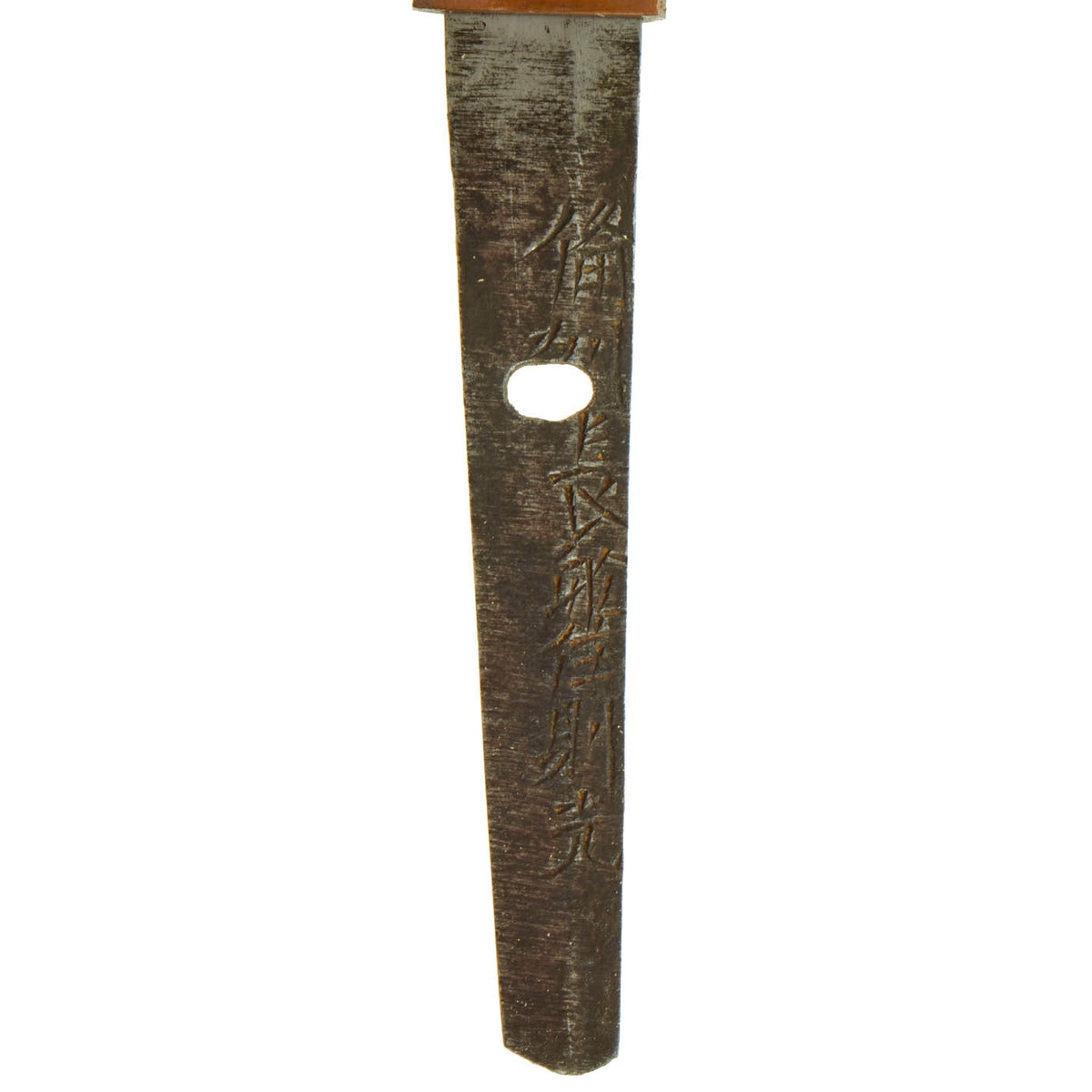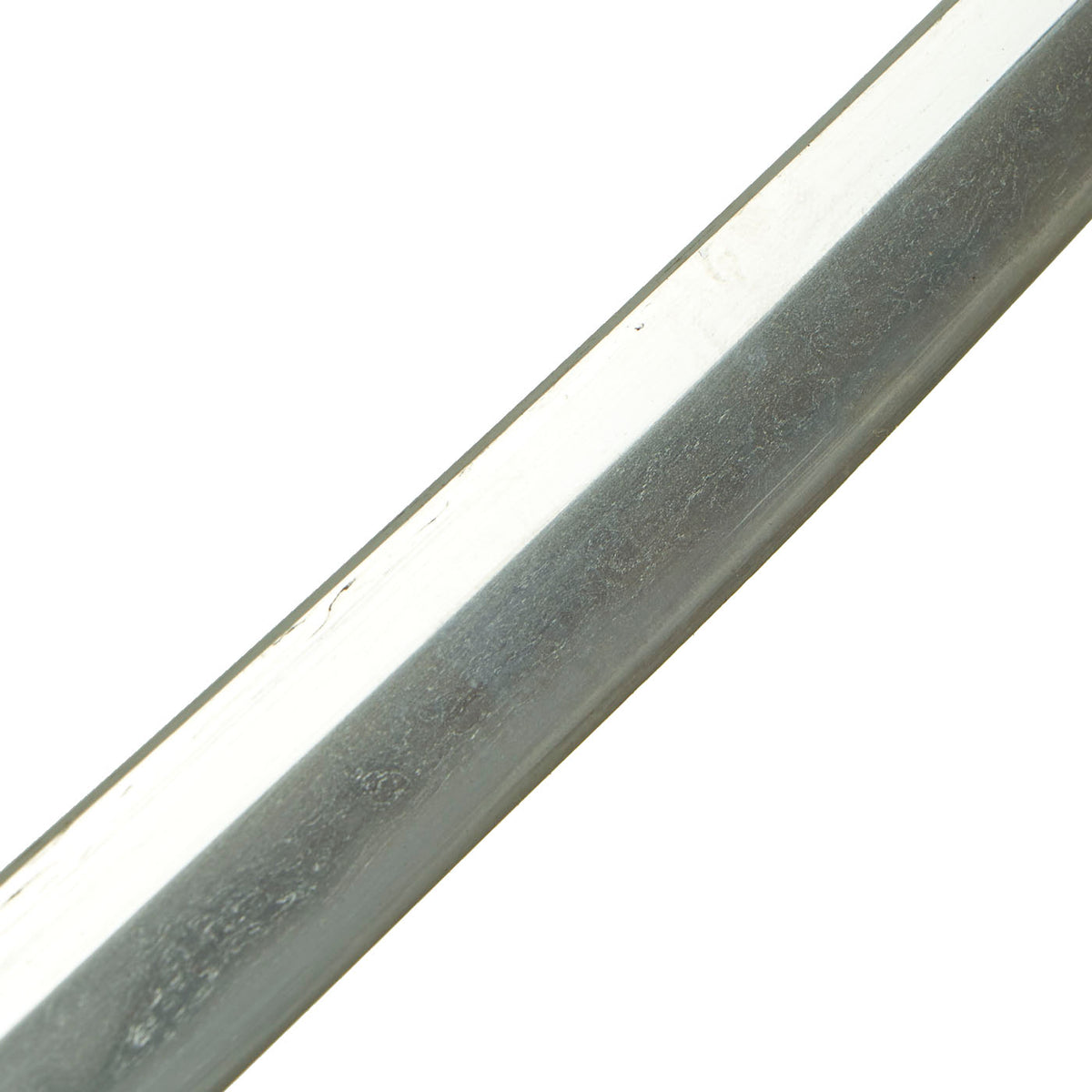Original 15th-16th Century Japanese Ko-Wakizashi Signed BISHU OSAFUNE JU NORIMITSU in Resting Scabbard Original Items
$ 2.195,00 $ 548,75
Original Item: Only One Available. Wakizashi (脇差 “side inserted / companion sword”) is a general term for a sword between one and two shaku long (30 cm and 60 cm). Generally it is the short blade that accompanies a katana in the traditional samurai daisho pairing of swords, but may be worn by classes other than the samurai as a single blade, also worn edge up as the katana.
This example is is towards the lower side of the blade length range, so it would often be termed a “Ko-Wakizashi” for a “Small Wakizashi”. The blade is relatively small in width, with a narrow tang. However, it has a “Shinogi Zukuri” shape, the most common shape used, and the standard for the longer Katana. It’s possible that this was intended as a shorter sword for a child, as it looks pretty much like a scaled down katana. It comes in a very nice modern production sword bag.
As best we can tell, this sword dates from the Muromachi period (室町時代 Muromachi jidai) of 1336 to 1573, most likely the mid to late portion. This is part of the period of Japanese swordmaking known as Kotō (古刀”old swords”), the the type of swords that later smiths treated as the goal they needed to achieve.
The tang of the blade is signed by the maker (mei) with 備 州 長 船 住 則 光 – BISHU OSAFUNE JU NORIMITSU, which basically means that the smith named Norimitsu of the Osafune School made this sword in Bishu, or Bizen Province. This is a province with a long history of legendary schools of Japanese swordsmithing. Those who forged swords in the Bizen province, today known as Okayama prefecture, at the end of the Muromachi Period (1492-1569 A.D) are called Matsu Bizen. There were multiple generations of smiths in the Osafune school using this name from the start of the 14th century up until the late 16th century. It is a highly rated name and many great examples have been recorded by this smith.
This example has most likely been remounted several times, as was common for Japanese blades. This has made the file marks on the tang somewhat faint, and is also why the hole in the tang is somewhat oblong. It was then put into a “resting scabbard” for long term storage.
The blade has the following period correct features:
– Folded steel blade (fold lines are evident on the spine and body of the blade)
– hole in the tang (mekugi-ana) is punched and not drilled
– blade is signed on the tang by the maker
– blade has a temper line (hamon), which is easily visible.
– lade shows hada (grain) in the blade body (ji), only possible with laminated steel
– Blade wounds (kizu) or lamination artifacts are present on the blade, only possible on traditionally made examples. These are mostly WARE (lamination lines).
The blade of this example is 13 inches long, and the polish on the blade is in excellent condition, showing all of the important features of the blade. The edge is still quite sharp, with no nicks or dents that we can see, and just a few specs of staining. The tang (nakago) is of the futsu 普通 (regular) style, with a Naagari (asymmetrical rounded) nakago-jiri (tang tip). Overall length of this wakizashi is 18 1/8 inches in the resting handle.
The hamon (temper line) is clearly visible, and is of the SUGUHA (straight) shape with a bit of NOTARE (wave / swell) aspects, with a lot of activity. Nie Crystals are visible, and there is Nioi cloudiness visible with lamination lines. The body of the blade shows ITAME (woodgrain) HADA (grain), and the boshi (tip temper line) is of the YAKIZUME (no turnback) type. The Yokote (division between the tip and blade body) is crisp and highly visible. With the long delay for traditional togishi polishing, blades that are ready to display are definitely in demand.
This sword is mounted in a “resting scabbard” or Shirasaya, which is intended for storing the blade when it is not in use. This has the standard form, with a simple wooden grip and scabbard, with some wooden fittings on the ends. There is a bit of light wear to the scabbard, but no major damage or staining. The koiguchi (scabbard mouth) trim is missing a small bit of the wooden trim, and there is also a small split at the top of the scabbard. Otherwise condition of the saya and tsuba is excellent, with a very nice mekugi cross pin.
A fantastic late Muromachi period wakizashi by a famous lineage of makers in the legendary Osafune School of Bizen province, ready to display!
Specifications:
Blade Length: 13″
Blade Shape: Shinogi Zukuri
Overall length: 18 1/8“
Scabbard Length: 14 7/8″
It has been over one thousand years ago that the art of making swords appeared in Japan. The swordsmiths of the time may not have known it but they were creating a legendary sword. The Samurai sword has seen combat in many battlefields. From the early days of the Samurai warrior to the fierce battles in the South Pacific during WWII.
Each hand-made Japanese blade (日本刀 – Nihonto) is unique because it is forged from multiple pieces of folded steel stock. A tremendous amount of work is dedicated to creating these pieces. They were an instrument of war as much as a beautiful artifact to adorn a room.
The traditional Japanese blade and mountings have grown to be one of the most highly desired military antiques.
Fast Shipping with Professional Packaging
Thanks to our longstanding association with UPS FedEx DHL, and other major international carriers, we are able to provide a range of shipping options. Our warehouse staff is expertly trained and will wrap your products according to our exact and precise specifications. Prior to shipping, your goods will be thoroughly examined and securely secured. We ship to thousands clients each day across multiple countries. This shows how we're dedicated to be the largest retailer on the internet. Warehouses and distribution centres can be located throughout Europe as well as the USA.
Note: Orders with more than one item will be assigned a processing date depending on the item.
Before shipping before shipping, we'll conduct a thorough inspection of the items you have ordered. Today, the majority of orders will be delivered within 48 hours. The delivery time will be between 3-7 days.
Returns
The stock is dynamic and we cannot completely manage it because multiple stakeholders are involved, including our factory and warehouse. So the actual stock may alter at any time. It's possible that you may not receive your order once the order has been made.
Our policy is valid for a period of 30 days. If you don't receive the product within 30 days, we are not able to issue a refund or an exchange.
You can only return an item if it is unused and in the same state as the day you received it. You must have the item in its original packaging.
Related products
Uncategorized
Uncategorized
Uncategorized
Uncategorized
Uncategorized
Uncategorized
Uncategorized
Band of Brothers ORIGINAL GERMAN WWII Le. F.H. 18 10.5cm ARTILLERY PIECE Original Items
Uncategorized
Uncategorized
Armored Burgonet Helmet & Polearm from Scottish Castle Leith Hall Circa 1700 Original Items
Uncategorized
Uncategorized
Uncategorized
Australian WWII Owen MK1 Machine Carbine SMG Custom Fabricated Replica with Sling Original Items
Uncategorized
Uncategorized
Uncategorized
Uncategorized
Uncategorized
Uncategorized
Uncategorized
Uncategorized
